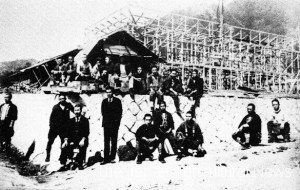
Kyozon hospital (co-existence hospital) of Sekisei riyokumiai (Sekisei utilization cooperatives), under construction (“Nichiharacho nogyokyodokumiai shi (History of Nogyokyodokumiai (agricultural cooperatives) of Nichihara town) “)
On July 22, 1931 (Showa 6), in Nichiharacho (now Tsuwano-cho) of Kanoashigun (Kanoashi county) of Shimane Prefecture, Kyozon hospital (co-existence hospital) of Sekisei riyokumiai (Sekisei utilization cooperatives) limited liability cooperatives was opened, servicing only medical business.10 persons including Masayo Oba were appointed to board members and 3 persons were appointed to auditors. The hospital’s name of “kyozon (co-existence)” was adopted from the words “kyozon kyoei (co-existence and co-prosperity)”, the philosophy of the modern cooperatives.
The hospital had 2 buildings of 2 stories (Total floor area 937 square meters). Medical subjects were internal, surgery, pediatrics, obstetrics and gynecology. 3 doctors worked. Pharmacy and X-ray laboratory were equipped. 16 nurses worked.
The doctor with reputation in the region died on the way to home during visiting medical examination due to accident, so that, in Nichiharacho, number of doctor became only one. On the other hand, opinion of Masayo Oba claiming “General Hospital established by cooperatives and covering wide area” became public opinion and was at once embodied. That was the opportunity of establishment of this hospital.
Medical expenses of Kyozon hospital (co-existence hospital) was suppressed cheaper and helped farmers. For example, in the case of a surgery of appendicitis, at Tokyo’s Keio hospital it costed 1500 yen. But at Kyozon hospital (co-existence hospital) it costed only 50 yen.
Impetuous opposition movement has occurred from the practitioner. In concert with anti-sangyokumiai (anti-cooperatives) movement, “Minsei Shimbun (People voice newspaper), monthly newspaper issued in this area, reported the opposite voice of practitioners every month. It had also shed false rumors such as “kyozon hospital takes too much X-ray, so that your life shrinks.”
Soon after the establishment, the hospital was received a solicitation of joining of Medical Association of Shimane Prefecture. However, it refused to join it, in order to be able to freely maintain medical care costs cheaper than the standard of Medical Association.
The first year of management is on track and accounted 1,470 yen of surplus. However, when it came to the second year, unpaid prescription charge increased more and more, 6,920 yen of deficit occurred. President resigned to take responsibility.
The Hospital opened branch hospitals in 4 area such as Tsuwano town and Masuda city. It worked to improve management by the scale expansion. However, uncollectible of funds continued to increase. Management was finally stalled. The second president also resigned. At last, Oba, who had advocated the theory of the hospital, was appointed to president.
At this point, total amount of debt was 72,295 yen. The building of hospital, X-ray machine set, and private property of board members including president Oba were pledged as collateral. The salary of doctors was cut to 2 thirds, and salary of nurses was also cut to 1 thirds.

The suicide note Masayo Oba wrote during hospitalization (collection of Museum of History and Folklore of Nichihara, Tsuwano Town of Shimane Prefecture)
On March 20, 1939 (Showa 14), Oba went to Tokyo to attend the emergency Executive Committee of the national council for medical utilization cooperatives. On the way back home, in the train, he was attacked by a severe low back pain. He made a stopover in Nagoya, and entered to hospital. By the result of abdominal surgery, disposal of appendicitis had been too late, and surgeries were ranged four times. 50 days passed from the announcement, on May 20, he died.
Oba seemed have realized difficulty of recovery. While still remaining on his back in bed, he wrote the last word testament to the wrapping paper spread by nurses. Testament was composed of chapters such as “my faith”, “to my children”, “to the cooperatives”, “to the hospital,” “to the branch office”, “to the prefectural federation.” To Kyozon hospital (co-existence hospital), he described to say, “Maintain the current policy”, and to credit and sales prefectural federation, he described to say ” Run your business actively. You should not lose your moderation for profit. ”
At Aohara Station of the Yamaguchi Line, “monument of teacher Masayo Oba” stands as towering. Its calligraphy was described by Yoriyasu Arima, the 5th president of sangyokumiaichuokai (general association of cooperatives). On the monument, it is introduced the achievements of Oba, who made efforts for sangyokumiai (cooperatives) movement exhaustively over a lifetime. (“Farmers medical movement history, ” ” History of Nogyokyodokumiai (agricultural cooperatives) of Shimane Prefecture, ” “Nichihara cooperatives history,” ” History of person and nogyokyodokumiai (agricultural cooperatives) of Shimane”)
◇
Later, the facilities had been managed by JA Sekisei Koseiren (Sekisei Federation of Nogyokyodokumiai (agricultural cooperatives) for Health and Welfare). But due to local aging and doctor shortages, its management became difficult, at last it was self-bankruptcy in 2008 (Heisei 20). Since April 2009, it was succeeded and managed by “Kisseido”, designated manager, which was invested by Tsuwano town and so on. Now 5 facilities such as Tsuwano kyozon hospital (Tsuwano co-existence hospital), Nichihara clinics, and long-term care health center for the elderly are operated.


